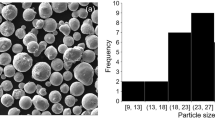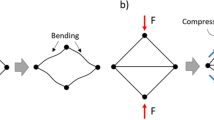Abstract
Laser powder bed fusion (LPBF) is one of the most potent additive manufacturing processes. One of the constraints for a broader industrial use of this process is the limited knowledge of its dimensional performances and geometrical behavior, as well as the inability to predict them as a function of material, process parameters, part size, and geometry. The objective of this study is to enrich knowledge of the geometric dimensioning and tolerancing (GD&T) performances of the LPBF process and to evaluate the distortion prediction capabilities of the ANSYS Additive Print® software. To this end, a selected topologically optimized part with three different support configurations was manufactured using an EOSINT M280 printer and AlSi10Mg powder. After printing, the parts were scanned using a coordinate measuring machine (CMM) and a micro-computed tomography (μ-CT) system. The GD&T calculations were carried out according to the ASME Y14.5 (2009) standard. The distortions measured by the CMM and μ-CT techniques were 0.195 mm and 0.368 mm, respectively (95% interval). After the software calibration and two numerical sensitivity studies, the same stereolithography files used to print the parts were downloaded into the ANSYS Additive Print® software to calculate distortions caused by the process. The differences between the experimentally measured and the ANSYS-predicted distortions for a 56 mm × 58 mm × 137 mm part fell within a 0.134 mm range at a 95% interval. The fidelity of the numerical predictions, the impact of the support structures, and the differences induced by the CMM and μ-CT measurement uncertainties are presented and discussed.



















Similar content being viewed by others
References
ASTM I (2016) ASTM52901-16 standard guide for additive manufacturing–general principles–requirements for purchased AM parts. ASTM International, West Conshohocken
DIN E (2017) ISO/ASTM 52900: 2017-06 additive manufacturing—general principles—terminology (ISO/ASTM 52900: 2015). German version EN ISO/ASTM 52900
Liu J, Jalalahmadi B, Guo Y, Sealy MP, Bolander N (2018) A review of computational modeling in powder-based additive manufacturing for metallic part qualification. Rapid Prototyp J 24(8):1245–1264
Afazov S, Okioga A, Holloway A, Denmark W, Triantaphyllou A, Smith S-A, Bradley-Smith L (2017) A methodology for precision additive manufacturing through compensation. Precis Eng 50:269–274
Afazov S, Denmark WA, Toralles BL, Holloway A, Yaghi A (2017) Distortion prediction and compensation in selective laser melting. Addit Manuf 17:15–22
An K, Yuan L, Dial L, Spinelli I, Stoica AD, Gao Y (2017) Neutron residual stress measurement and numerical modeling in a curved thin-walled structure by laser powder bed fusion additive manufacturing. Mater Des 135:122–132
Parry L, Ashcroft I, Wildman RD (2016) Understanding the effect of laser scan strategy on residual stress in selective laser melting through thermo-mechanical simulation. Addit Manuf 12:1–15
Caelers M (2017) Study of in-situ monitoring methods to create a robust SLM process: preventing collisions between recoater mechanism and part in a SLM machine
Nicoletto G (2017) Anisotropic high cycle fatigue behavior of Ti–6Al–4V obtained by powder bed laser fusion. Int J Fatigue 94:255–262
Gan MX, Wong CH (2016) Practical support structures for selective laser melting. J Mater Process Technol 238:474–484
Moges T, Ameta G, Witherell P (2019) A review of model inaccuracy and parameter uncertainty in laser powder bed fusion models and simulations. J Manuf Sci Eng 141(4):040801
Markopoulos AP (2012) Finite element method in machining processes. Springer Science & Business Media
Dunbar AJ, Denlinger ER, Gouge MF, Michaleris P (2016) Experimental validation of finite element modeling for laser powder bed fusion deformation. Addit Manuf 12:108–120
Mukherjee T, Zhang W, DebRoy T (2017) An improved prediction of residual stresses and distortion in additive manufacturing. Comput Mater Sci 126:360–372
Denlinger ER, Gouge M, Irwin J, Michaleris P (2017) Thermomechanical model development and in situ experimental validation of the laser powder-bed fusion process. Addit Manuf 16:73–80
Yaghi A, Afazov S, Villa M (2019) Additive manufacturing process chain modelling and simulation. NAFEMS World Congress 2019:24
Chen J-m, Lu H, Wang J-h, Chen W-x, Hao D-j Prediction of welding deformation with inherent strain method based on FEM
Wang Y-X, Zhang P, Hou Z-G, Li C-Z (2008) Inherent strain method and thermal elastic-plastic analysis of welding deformation of a thin-wall beam. J Mech 24(4):301–309
Ueda Y, Fukuda K, Tanigawa M (1979) New measuring method of three dimensional residual stresses based on theory of inherent strain (welding mechanics, strength & design). Trans JWRI 8(2):249–256
M. Tateishi, HS, P. Mehmert (2019) Automated distortion compensation functionality for metal additive manufacturing. NAFEMS World Congress 2019:18
Setien I, Chiumenti M, van der Veen S, San Sebastian M, Garciandía F, Echeverría A (2019) Empirical methodology to determine inherent strains in additive manufacturing. Comput Math Appl 78(7):2282–2295
Keller N, Ploshikhin V New method for fast predictions of residual stress and distortion of AM parts. In: Solid freeform fabrication symposium (SFF), Austin,2014. pp 4–6
François M, Segonds F, Rivette M, Turpault S, Peyre P (2019) Design for additive manufacturing (DfAM) methodologies: a proposal to foster the design of microwave waveguide components. Virtual and Physical Prototyping 14(2):175–187
Engineers ASoM (1995) Mathematical definition of dimensioning and tolerancing principles: ASME Y14. 5.1 M-1994. American Society of Mechanical Engineers
TC69 I (2013) SC4—applications of statistical methods in process management: ISO. TR 22514-4: 2007—statistical methods in process management—capability and performance—part 4: process capability estimates and performance measures. Published standard
ANSYS (2018) ANSYS additive user’s guide release 19.2.62
ANSYS (2018) ANSYS additive print calibration guide release 19.2.18
Wang J, Sama SR, Manogharan G (2019) Re-thinking design methodology for castings: 3D sand-printing and topology optimization. Int J Met 13(1):2–17
Del Re F, Contaldi V, Astarita A, Palumbo B, Squillace A, Corrado P, Di Petta P (2018) Statistical approach for assessing the effect of powder reuse on the final quality of AlSi10Mg parts produced by laser powder bed fusion additive manufacturing. Int J Adv Manuf Technol 97(5–8):2231–2240
GmbH EOS (2016) Material data sheet: EOS aluminium AlSi10Mg (for EOS M280).5
Aluminum A360.0-F die casting alloy. MatWeb. http://www.matweb.com/search/DataSheet.aspx?MatGUID=87a0d0817ebd44008a967cbf3e9cd378&ckck=1
Dixon WJ, Massey Jr FJ (1951) Introduction to statistical analysis
Barbero BR, Ureta ES (2011) Comparative study of different digitization techniques and their accuracy. Comput Aided Des 43(2):188–206
Aloisi V, Carmignato S (2016) Influence of surface roughness on X-ray computed tomography dimensional measurements of additive manufactured parts. Case Studies in Nondestructive Testing and Evaluation 6:104–110
Kessel W (2002) Measurement uncertainty according to ISO/BIPM-GUM. Thermochim Acta 382(1–2):1–16
Zongo F, Tahan A, Aidibe A, Brailovski V (2018) Intra-and inter-repeatability of profile deviations of an AlSi10Mg tooling component manufactured by laser powder bed fusion. J Manuf Mater Process 2(3):56
Acknowledgments
The authors are thankful to Joel Grignon and Morgan Letenneur who assisted in the research.
Funding
The study received financial support from the Natural Sciences and Engineering Research Council of Canada and École de technologie supérieure (ETS).
Author information
Authors and Affiliations
Contributions
The project objectives and methodology were proposed by A.T. and V.B. The specimen fabrication, scanning, and data treatment were carried out by F.Z. The numerical simulations were carried out by A.Ti. and C.S. The article was written by F.Z. and revised by C.S., A.Ti., A.T., and V.B.
Corresponding author
Ethics declarations
Conflict of interest
The authors declare that they have no conflicts of interest.
Additional information
Publisher’s note
Springer Nature remains neutral with regard to jurisdictional claims in published maps and institutional affiliations.
Appendices
Appendix 1
Appendix 2
Figure 20 illustrates stress distributions within the shape A artifact for all four simulations. It can be seen that for LE stress mode, local stresses surpass the ultimate strength (US) of the material (460 MPa), while it is not the case of the elastoplastic stress mode (J2P). The same effect can be observed for shape B-P2 in Fig. 21.
Stress distribution of shape A artifact for the four simulations modes. Stresses below YS in green, between YS and US in yellow, and above US in red. Assumed strain simulation with a linear elastic stress mode (AS LE) and b elastoplastic stress mode (AS J2P). Scan pattern simulation with a linear elastic stress mode (SP LE) and b elastoplastic stress mode (SP J2P)
Stress distribution of shape B-P2 for the four simulations modes. Stresses below YS in green, between YS and US in yellow, and above US, in red. Assumed strain simulation with a linear elastic stress mode (AS LE) and b elastoplastic stress mode (AS J2P). Scan pattern simulation with a linear elastic stress mode (SP LE) and b elastoplastic stress mode (SP J2P)
Appendix 3
Appendix 4
The pedestal effect was investigated through artifact 1 (no pedestal) and artifact 3 (having a pedestal) experimental deviations. The results are presented in Table 8 and Fig. 25.
Appendix 5
The part removal effect was investigated through artifact 3 experimental deviations measured before and after being removed from the build plate. The results are presented in Table 9 and Fig. 26.
Rights and permissions
About this article
Cite this article
Zongo, F., Simoneau, C., Timercan, A. et al. Geometric deviations of laser powder bed–fused AlSi10Mg components: numerical predictions versus experimental measurements. Int J Adv Manuf Technol 107, 1411–1436 (2020). https://doi.org/10.1007/s00170-020-04987-7
Received:
Accepted:
Published:
Issue Date:
DOI: https://doi.org/10.1007/s00170-020-04987-7











